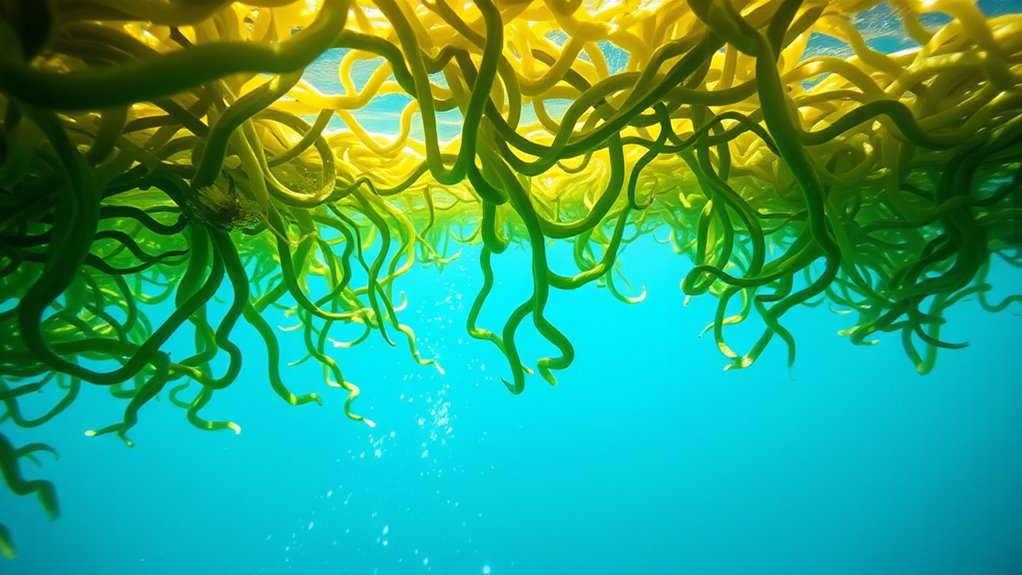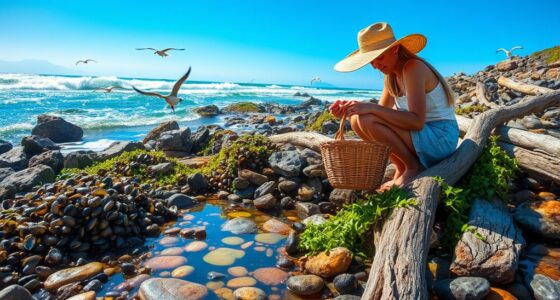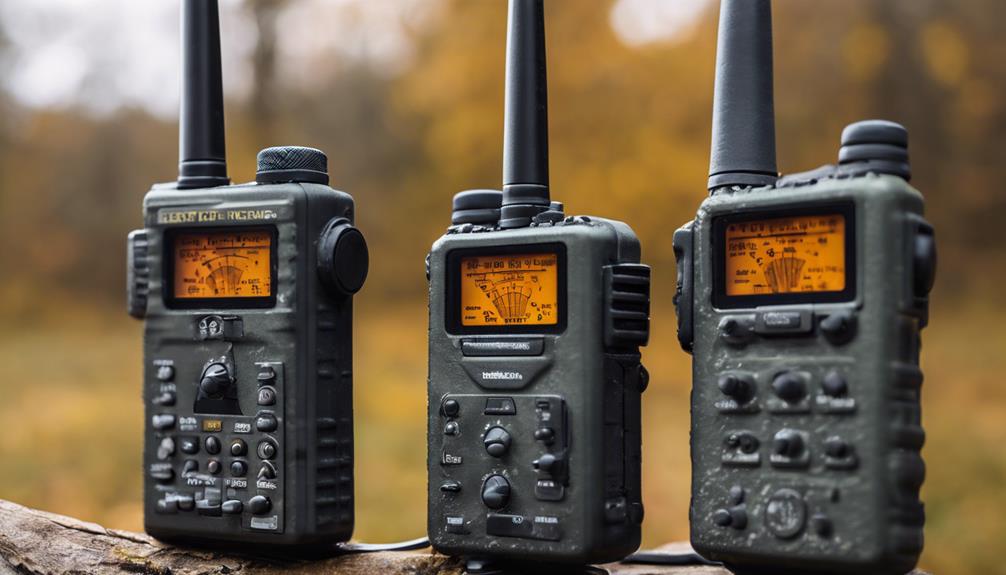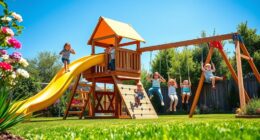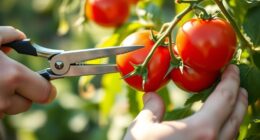Kelp rafts and drift lines reveal how ocean currents move nutrients and organic matter across vast areas, creating essential habitats for marine life and potential superfoods like seaweed. These floating ecosystems serve as natural indicators, showing where rich resources gather and how they support biodiversity. By understanding these clues, you can see how the ocean sustains life and discover sustainable, nutritious foods. Keep exploring to uncover more secrets behind these floating treasures.
Key Takeaways
- Floating kelp rafts and drift lines serve as natural indicators of nutrient-rich zones, guiding sustainable harvesting of edible seaweeds.
- Ocean currents distribute organic debris and kelp, revealing patterns that help locate areas abundant in superfoods like seaweed.
- These floating habitats support diverse marine life, providing opportunities for sustainable foraging of nutritious aquatic plants.
- Monitoring drift lines allows identification of productive regions for wild, natural seaweed harvesting without disrupting ecosystems.
- Understanding the movement and accumulation of organic matter helps maximize the collection of free, nutrient-dense superfoods from the ocean.

Have you ever wondered how floating kelp forests and drift lines support marine life? These natural phenomena serve as essential ecosystems, providing shelter, food, and pathways for countless marine species. One of the fascinating ways they do this is by collecting marine debris and other organic materials, creating a floating habitat that benefits many creatures. When ocean currents carry debris and organic matter across vast distances, they form dense mats and lines of floating kelp and other plant matter. These currents act like underwater highways, guiding nutrients and organic materials to different parts of the ocean. As a result, marine debris—such as bits of plastic, algae, and dead plant material—accumulates in these floating forests, which may seem like trash but actually serve as key resources for marine organisms.
Floating kelp forests and drift lines collect debris and organic matter, creating vital habitats that support marine life.
Kelp rafts and drift lines act as natural gathering spots for marine life. Small fish and invertebrates seek refuge among the tangled kelp, hiding from predators and finding abundant food sources. Larger animals, like sea turtles and seabirds, follow these floating forests, knowing they often harbor prey or serve as resting points during long migrations. The organic materials collected in these floating ecosystems are rich in nutrients, supporting the growth of tiny plankton and algae, which are the foundation of the ocean’s food chain. This makes kelp rafts and drift lines important for maintaining healthy marine populations, especially in areas where other food sources might be scarce. Additionally, the high nutrient content of these floating habitats enhances their role as vital feeding grounds.
The role of ocean currents in shaping these floating ecosystems cannot be overstated. Currents move and concentrate organic debris and kelp, creating predictable patterns that marine life relies on. They distribute nutrients across different regions, helping sustain biodiversity and productivity in open waters far from coastlines. When currents push organic matter together, they form dense mats that serve as floating gardens teeming with life. These floating habitats are also essential in transporting nutrients and organic materials over long distances, ensuring that life can thrive even in remote areas of the ocean. By reading these ocean clues—like where kelp and debris accumulate—you can gain insights into the health and dynamics of marine environments, as well as discover natural sources of superfoods like seaweed and other edible aquatic plants, which are often harvested from these floating ecosystems.
In essence, kelp rafts and drift lines are more than just floating debris—they’re key components of the ocean’s intricate web of life. They demonstrate how ocean currents shape the movement of nutrients and organic matter, creating habitats that sustain countless species. Recognizing these floating ecosystems allows you to understand the natural flow of marine resources and the potential for discovering nutritious, sustainable foods directly from the ocean’s bounty.
Frequently Asked Questions
How Do Kelp Rafts Impact Local Marine Ecosystems?
Kelp rafts considerably impact local marine ecosystems by enhancing habitat complexity and supporting marine nutrient cycling. As you observe these floating kelp, you realize they provide shelter and breeding grounds for various marine creatures, boosting biodiversity. By facilitating the transfer of nutrients across ocean surfaces, kelp rafts help sustain the food web. Your understanding shows how these natural elements play a crucial role in maintaining healthy, productive ecosystems.
Can Kelp Rafts Be Used for Sustainable Harvesting Methods?
Kelp rafts can indeed enable sustainable harvesting by supporting kelp farming and renewable harvesting methods. Imagine harnessing ocean currents to grow and collect kelp gently, without damaging ecosystems or depleting wild populations. You can promote eco-friendly practices while ensuring a steady supply of nutritious superfoods. By using kelp rafts, you turn natural ocean movements into tools for responsible harvests, protecting marine life and supporting ocean health for future generations.
What Are the Primary Threats to Drifting Kelp Populations?
You should know that drifting kelp populations face major threats from climate change, which warms ocean waters and disrupts their growth. Pollution levels also harm these ecosystems by introducing toxins and debris that damage kelp beds. These factors weaken kelp’s ability to thrive and regenerate, leading to declines. To protect drifting kelp, addressing climate change and reducing pollution are vital steps to guarantee their sustainability and the health of ocean ecosystems.
How Long Do Kelp Rafts Typically Remain Afloat?
You might be surprised to learn that kelp raft longevity varies, often drifting for weeks or even months. When drift line formation occurs, it creates a natural buoyancy that keeps kelp afloat longer. Factors like currents and weather influence how long your kelp raft stays on the surface. Typically, these rafts remain afloat for several weeks, offering a fascinating glimpse into the ocean’s dynamic ecosystem and the resilience of drifting kelp.
Are There Any Health Risks Associated With Consuming Drift Line Seaweed?
You might wonder if consuming drift line seaweed poses health risks. It can carry toxin accumulation and contaminants exposure from polluted waters, which may lead to health issues. Always be cautious and verify if the seaweed is sourced from clean areas before eating. Avoid collecting seaweed from questionable or industrial zones to reduce risks and enjoy the nutritional benefits without risking your health.
Conclusion
As you explore the ocean’s clues, remember that kelp rafts and drift lines are more than just debris—they’re vital ecosystems. Did you know that up to 70% of the ocean’s surface can be covered in these floating forests during peak seasons? By understanding and protecting these natural super-foods, you can help preserve marine life and access their health benefits. So next time you see a kelp raft, consider its incredible role in our ocean’s health.

